St. Jean – Honto (4.7m)
Leaving St. Jean Pied de Port on your first day of the Camino Frances can be daunting prospect: it’s an arduous 15.5 mile hike up and over the Pyrenees and across the Spanish border to Roncesvalles, the first place a weary pilgrim can rest, refuel and find a bed for the night. It’s also climb from about 400ft above sea level to over 4700ft, which can leave some hopeful hikers gasping for breath and wondering what in God’s name they were thinking…
But because I am a gentleman of a certain vintage I decided to test my gear in the foothills, so to speak, staying the night in the hamlet of Honto, just five miles up the road from St Jean, but hiking another five miles past it before retracing my steps, to see how new(ish) Hoka Anacapa hiking shoes and my 20lb Osprey backpack treated me. The answer was: pretty good, no back pain and no blisters.
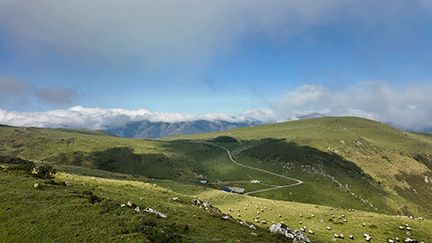
Our turnaround spot was Refuge D’Orisson, located at about 3,000ft and wreathed in fog. As we stopped for one of countless coffees and to watch other hikers come and go, two ambulances screamed by with lights flashing and sirens blaring. Somebody had obviously overdone it on the first day.
After retracing our steps downhill to Honto and checking into Ferme Ithurbia, we shared a simple but hearty ‘pilgrim meal’ with 24 other pilgrims from around the world, enjoying good night’s sleep before the battle began in earnest the following day.
And on the subject of pilgrims: official figures suggest no fewer than 220,000 pilgims completed the Camino Frances in 2023, with Spanish are the most numerous nationality, followed by Americans, Germans, Italians and Portuguese. We also met many Brits, Aussies and a surprisingly high number of Koreans, especially younger ones, for whom ‘doing a Camino’ has become very fashionable in recent years.
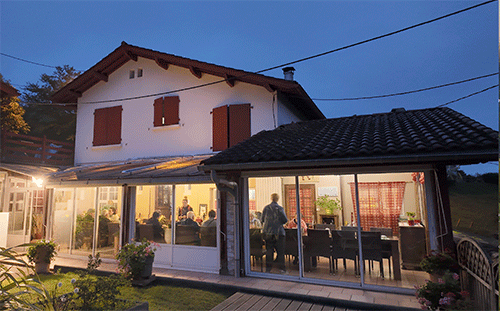
Honto-Espinal (15m): We were up at dawn to share a pilgrim’s breakfast with our fellow travellers, and stepping out on the road we greeted by a cold and misty morning. But as we pounded the pavement which soon gave way to a dirt track, the sun rose, banishing the clouds and bathing us in sunshine. We were in high spirits as we began an arduous uphill climb on what is known as the RouteNapoleon. We breezed past Refuge D’Orisson and strode boldly up towards Col Leopoder, the highest spot in this section at 4750ft. We were rewarded for our efforts with spectacular views out over the Pyrenees and the company of countless sheep (of the four legged variety). It was a little cold and blustery up there, but nothing too daunting, although even in high summer sudden storms can prompt some hikers to take the alternative (read: lower) Valcarlos route. The mood among those around us seemed confident, even a little giddy, rather like raw recruits going into battle blithely oblivious of the horrors that await them. Make no mistake, this is a tough uphill climb, but burning quads uphill are infinitely preferable to the aching knees and ligaments which the downhill segment brings. After crossing into Spain at the famed Fountain of Roland (so named for one of Charlemagne’s generals who met a sticky end here in the 9th century), it was mostly downhill over rocky ground. This made for exceptionally difficult and painful going. Our progress, so confident earlier in the day, slowed to a crawl as we gingerly made our way down towards Roncesvalles.
This place is famed for its large and well equipped pilgrim’s hostel (albergue), but sleeping accommodation is all shared dormitories, and my partner and I wanted privacy, so we had resolved to push on another three miles to the village of Espinal, where a comfortable bed was waiting at the confusingly-named Casa Rural Roncesvalles.
But first we had to refuel, so over café con leches and fried croquetas I somewhat shamefacedly mooted the idea of grabbing a taxi for the final push. My partner was willing but fortunately (?) none were available for at least two hours, so we pushed on. Although the walk was easy and along a delightfully shaded riverside path, we were both in miserable moods. When Espinal finally hove into view, we sighed with relief.
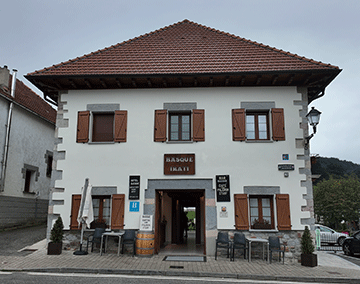
Our room at the Casa Rural was comfortable and quiet and a hearty meal of pig’s knuckle and french fries, washed down by a carafe of hearty local red wine at a neighboring taberna were just what we needed. That and a very sound sleep.
Espinal–Larrasoana (13m) We had just enteredNavarra, a proud andhistoric corner of Spain,which really brought into focus the stark differences between the northern and southernparts of the country. This is a defiantly Basque region, full of rolling fields, thick forests, surging rivers and productive farmland. It’s about as far from the rampant development and monstrous walls of endlessly white hotels of the Costa del Sol as you can imagine. The locals are proud but friendly and hospitable, and the food is hearty, highlighting roasted meats and game, outstanding sheep’s milk cheeses and lusty Navarran wines.
After the exposed hike up the Pyrenees from the day before, the jour ney to Larrasoana was leisurely, sheltered and peaceful. Our digs for the night was the Hotel Akerreta, featured briefly in the 2014 Camino movie The Way. Our host was Jorge, a friendly and gentle man who manned reception, took our dinner orders and told endless stories about his ‘peregrino’ (pilgrim) clients. It was a gentle respite before the next day’s slog.
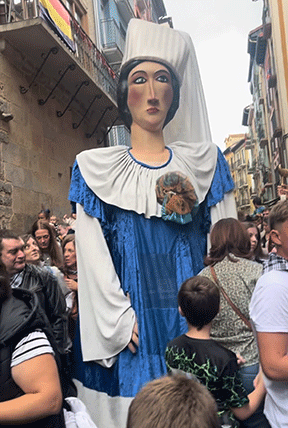
Larrasoana–Pamplona (9m) The day dawned greyand threatening for ourhike into the busy townof Pamplona. We had waterproof covers for our backpacks and the requisite cheap n’ cheerful ponchos to ward off the rain. And boy, did we need them. The skies opened barely ten minutes after we left our hotel and we were dumped on for the best part of three hours. The dirt roads turned into mushy ponds and small streams, slowing our progress and dampening our spirits. But on the flip side, this was a comparatively short day at barely 10miles, and we were en route to a town I have always wanted to visit.
Pamplona is home to the famed San Fermin Festival – the Running of the Bulls – and the setting for Hemmingway’s The Sun Also Rises. After reaching the old town and settling into the Casa Ibarrola albergue, run by two kind and funny brothers, Cesar and Iraki, we set out to explore. In contrast to the peace of the last three days, Pamplona was a riot. The streets were jammed with locals due to the ‘mini San Fermin’ festival taking place, where Pamplonans from various San Fermin ‘clubs’ played music, danced and drank, each group easily identifiable by their differently-colored neckerchiefs and favored club songs and chants. Imagine the least threatening football fans you’ve ever met and you will get the idea.
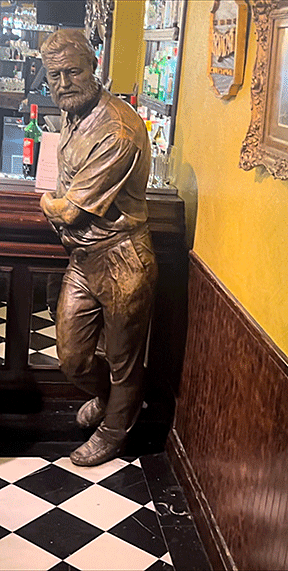
The almost constant rain didn’t seem to deter their revelry, which was in full flow by noon on Friday and still going at 4am Sunday! Our room looked out onto a hugely popular local bar, and it wasn’t until almost dawn that the revelers would finally drift away to their beds.
Pamplona is a terrific food town, which endless little alleys offering mouthwatering tapas or pinchos and cheap wine, beer or cider. We made an obligatory stop at the famed Café Iruna, Hemmingway’s favorite watering hole in the 1920s, where we quaffed a couple of absolutely outstanding Gin & Tonics at the ‘Hemmingway Corner’, where a bronze statue of the great man props up the bar, making for the perfect Instagram moment for a steady stream of tourists who pop in for a gander. By now we were barely 40 miles into our 500 mile pilgrimage. Our bodies were adjusting, our Spanish improving, and we had hit no real walls, either physical or mental.
So far, so bueno.
